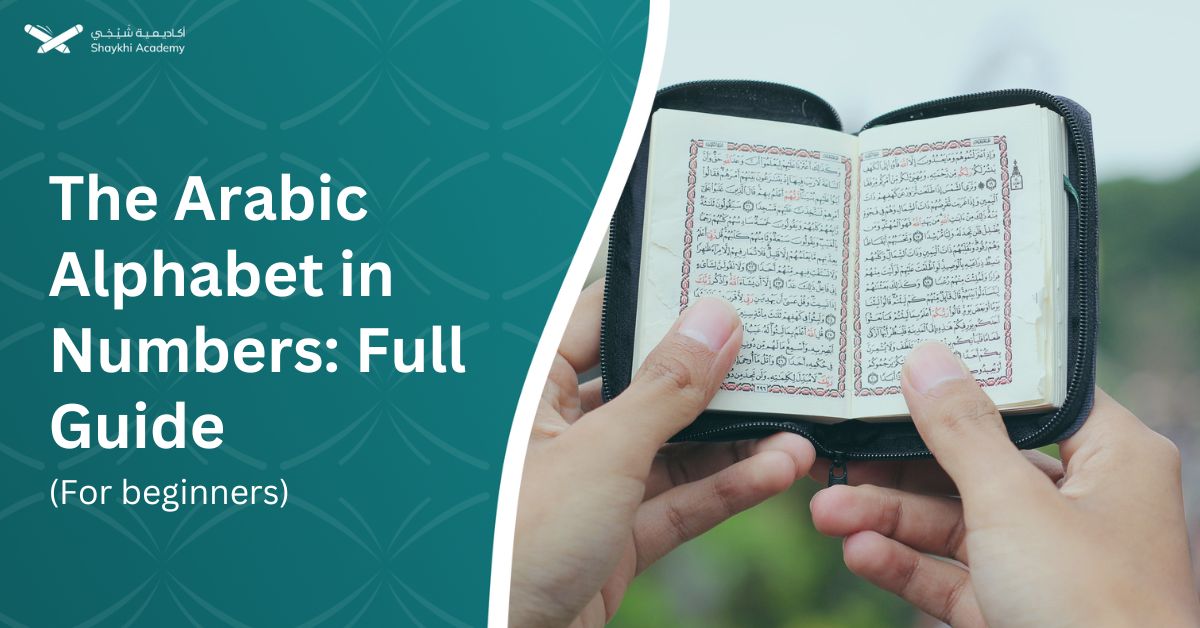The Arabic Alphabet in Numbers: In the realm of Arabic writing systems, a unique and informal approach emerges known as Arabizi, where numbers play a distinctive role, and as unique as this system is, its uses are equally unique.
What is the Arabic Alphabet in Numbers?
The relationship between the Arabic alphabet and numbers in the context of Arabizi, an informal style of writing Arabic using Latin script and numbers, is based on phonetic approximation.
Arabizi is the representation of Arabic alphabet in numbers, and latin letters, and it’s primarily used in digital communication, text messaging, and social media, where using Arabic script might be impractical due to keyboard limitations and other factors.
Arabizi is different from the Modern Standard Arabic (MSA), which is usually used in official and formal encounters, and is the language usually taught by educational academies; such as the MSA courses of Shaykhi Academy.
In Arabizi, each Arabic letter is assigned a corresponding number based on the phonetic sound it represents. The mapping of letters to numbers is not standardized, and different variations exist.
For example, the letter “و” (waw) in Arabic may be represented by the number 6 in Arabizi. This correlation is not based on the numerical value of the Arabic letters but rather on the sounds they produce.
Read: How to learn Arabic Alphabet?
What is the Arabizi Alphabet?
In Arabizi, which is Arabic scripts in English, Arabic words and sounds are transliterated into the Latin alphabet, and numbers are often used to represent sounds that do not have direct equivalents in English. The incorporation of Arabic scripts into English through Arabizi allows Arabic speakers to write and communicate in their native language using the available English keyboard.
The Arabizi alphabet consists of:
1- Arabizi letters:
The Arabizi letters are the representation of Arabic scripts in the English alphabet, which are used in script as equivalent for the similar Arabic sounds and letters.
2- Arabizi numbers:
The Arabizi numbers are the representation of the Arabic alphabet in numbers that represent the sounds and letters, which do not exist in the Latin alphabet.
- The number 3 represents the Arabic letter “ع” (Ain), a guttural sound that doesn’t have an equivalent in English.
- The number 6 represents the Arabic letter “و” (Waw), which is similar to the English “w” sound.
- The number 7 represents the Arabic letter “ح” (Ha), a guttural sound.
- The number 8 represents the Arabic letter “خ” (Kha), another guttural sound.
- The number 9 represents the Arabic letter “ق” (Qaf), a sound that is somewhat similar to the English “k” sound.
- The number 2 represents the Arabic letter “ء” (Hamzah), a glottal stop.
Also learn more about Arabic Alphabet Book: Printable, Online, and English Version.
In Which Contexts Arabizi Isn’t Suitable?
Arabizi, being an informal and adapted writing system for Arabic using Latin letters and numbers, is generally not suitable for formal or official contexts. Here are some contexts where using Arabizi may not be appropriate:
1- Formal Writing:
In formal documents, official communications, academic papers, and other contexts that require a standardized and well-established writing system, it is more appropriate to use the standard Arabic script or an accepted transliteration system. The curricular material of Shaykhi Academy is amenable to this rule, and Al-Menhaj book makes use of MSA only.
2- Professional Communication:
In professional and business communication, it is advisable to use a more formal and universally accepted mode of writing, which typically involves the standard Arabic script or transliteration methods approved for specific fields.
3- Educational Settings:
In formal educational settings, such as classrooms, exams, and academic papers, the standard Arabic script or an approved transliteration system is preferred. So, utilizing MSA in conducting the kids’ Arabic classes at Shaykhi Academy ensures consistency and clarity in communication.
4- Official Documents and Legal Matters:
In official documents, legal contracts, government forms, and other formal paperwork, using the standard Arabic script or an officially recognized transliteration system is essential to avoid any misunderstandings or discrepancies.
5- Cultural or Religious Texts:
When dealing with cultural or religious texts, it is customary to use the standard Arabic script to preserve the authenticity and respect the traditional form of the language. Therefore, Shaykhi Academy’s Quran recitation courses usually utilize MSA, even if it was carried out online.
6- International Communication:
In international contexts where a standardized transliteration system is more widely understood and accepted, using Arabizi may lead to confusion. The International Phonetic Alphabet (IPA) for Arabic is an example of a more standardized approach for representing Arabic sounds.
Read Aslo: Where to learn Arabic: countries, universities, and websites.
Study Arabic with Native Arab Tutors Now!
Unlock the beauty of the Arabic language with Shaykhi Academy’s exceptional Arabic online courses and expert instructors!
Our dynamic learning platform caters to all levels, providing a personalized and effective way to learn Arabic. Elevate your language skills and cultural understanding – start your online classes today!
Click now to explore our courses and join a community passionate about Arabic language and culture.
These representations are used to convey Arabic sounds using the Latin alphabet and numbers, facilitating communication in online and digital contexts where Arabic script may not be readily available or practical, and since we are communicating online, tell us in the comments your favorite Arabizi word.

































